2024 Mazda CX-90 PHEV Review


Love It | Leave It |
|---|---|
Handsome, premium styling inside and out | Harsh ride |
Smooth PHEV integration | Dull infotainment |
Still fun for drivers | No great efficiency improvements |
Of the three versions of the 2024 Mazda CX-90, the plug-in hybrid was the one I was most curious about.
I don't need to tell you that Mazda's approach to electrification up until this point has been less than impressive. The MX-30 EV was a compliance vehicle, a novel wrapper hiding outdated tech at a punishing price. Now in rolls the CX-90, the Japanese brand's most concerted push upmarket yet, and it'll have the most complex of powertrains? Ruh-roh.
There was nothing to worry about. The 2024 Mazda CX-90 PHEV delivers on its promise of smooth power, good efficiency, and reasonable bursts of electric-only activity. It's biggest hurdle? The excellence of the standard engine.
What's new?
As we said when we first drove the CX-90 last spring, it's one of the rare vehicles where "all-new" makes sense. The entire platform is a ground-up design with a rear-drive bias, though like every other SUV the brand sells, the CX-90 comes with standard AWD. The standard turbocharged inline-six is a new design too, and the clearest sign of who exactly Mazda is targeting with this model. (Spoiler: it's zee Germans.)
The PHEV takes a different approach. It pairs Mazda's ubiquitous 2.5-liter inline-four—not the turbo one—with a 68-kilowatt electric motor. It keeps the eight-speed, wet-clutch automatic transmission, however. The combined performance is 323 horsepower and a turbo-six-matching 369 pound-feet of torque on premium fuel. Should the CX-90 drink from the commoner swill, it loses 4 hp. I'm positive nobody will notice, and I'd just stick to regular if it were my car.

Pulling from a 17.8-kWh battery pack, the CX-90 is rated to 26 miles (42 kilometers of electric range). When that's depleted, the three-row is rated at the same 25 mpg (9.4 L/100 km) combined as the turbo model.
Other than some small badging on the tailgate and aft of the front wheels, there are no obvious tells this CX-90 is down two cylinders. It's the same attractive package, with subtle cab-rearward proportions emphasizing its new platform. Even in white, the big SUV attracts lots of attention, and I had multiple folks ask me about it during our week together.
Quicker, Slower, Different

The electrified drivetrain subtly reframes the CX-90. Off the line, when both propulsion systems are working in unison, the big Mazda still feels quick, even hauling around the extra couple hundred pounds. That's all good for on-ramps. The PHEV starts to run out of breath earlier than its turbo siblings much beyond that, but after passing that dawdler in the right lane, what more do you need?
It's when the CX-90 is running on just one of its power sources that it can risk feeling a little tardy. Expected, but tardy nonetheless. In EV mode the CX-90 smoothly rolls along in near-silence, gathering speed in that methodical, deliberate way a train does. On the flip side, running just the 2.5-liter reveals a fine if unremarkable ICE experience. I had mistakenly believed this was the turbo-four before getting into the PHEV, yet after spending a week with it, I didn't find the nat-asp motor lacking. Even when the CX-90 is using the gas engine to recharge the battery, the engine is less audibly strained than the four-pot in the Toyota Highlander Hybrid.

That would be my nitpick, however: there's no easy way to force the CX-90 to only run on ICE power, and preserve the battery for later. Charge Mode sort of allows it: by using the ICE as a generator, drivers can select a battery percentage target, after which point the system only generates enough power to maintain that level. I'd prefer a simple button. Charging the battery the good old-fashioned way can take up to 11 hours on a household outlet.
When we first drove the CX-90, it was on winter rubber and in less than ideal conditions. It had a stiffer ride than most of its mainstream competition, but that lent it a more engaging personality. Here in the height of summer, the CX-90 still feels stiff, bordering on too much for something this size. The SUV calms down at highway speeds, finding a pleasant equilibrium there, though there's still a surprising amount of rear suspension noise that makes its way into the cabin over expansion joints.

The CX-90 still has some of the sweetest steering in the three-row class, with smooth responses and a good amount of weight in the rim. The brakes are also strong and consistent, including in the switch between friction and regenerative. Even the higher level of regen braking seems too modest, however.
Swanky, intimate cabin

The CX-90's cabin is a classy one. Tasteful bits of chrome and contrast stitching mix with soft-touch materials darned near everywhere. The quilted Nappa leather seats are supremely comfortable, and offer a range of adjustments to tailor the CX-90 driving position to most folks' needs. This tester does miss out on the more adventurous textiles and color scheme of the last CX-90 we had in though. It's a shame. The one odd piece out is the matte plastic surrounding the shifter. It looks weirdly cheap in a cabin that, otherwise, is every match for the premium offerings from the likes of Acura and Volvo.
This isn't the most spacious interior, however. Sure, the CX-90 has more way-back space than the CX-9, but 30.4 inches (772 millimeters) of legroom still puts it near the back of the pack. And the thick pillars make it quite a dark space, too. Drive around with all the seats up, and the 15.9 cubic feet (450 liters) of storage space is tiny as well. A small discrepancy for the PHEV: it loses the second-row seat ventilation the top-trim gas model has.

On the plus side, going for the PHEV provides zero penalties for either people or their things. All the important measurements align with the gas model. Value sheer stretch-out room over anything else? Honda will happily sell you a Pilot.
Media fumble

I won't harp on this too much, because we've done it time and time again: Mazda's infotainment is what holds the brand back. The rotary dial is fine for the main menu, and delivers on the brand's promise of minimal distraction there. But get into anything more complicated and it's a pain. Changing SiriusXM channels? Good luck. Apple CarPlay? Ha! Yes, touch controls do appear, when the car is stationary. But that's not going to help my passenger, the one stuck poking at a non-responsive screen. It's a big one, too, and (wireless) CarPlay takes up most of it, which is nice, but also frustrating. Speaking of wireless, the Qi charging pad is already too small for some phones.
The rest of the tech suite is better. The full digital instrument cluster moves Mazda into a new era, with crisp, customizable dials and a very handy adaptive cruise control screen. Speaking of, that system works well, especially in conjunction with lane tracing for a low-stress slog home at the end of a busy day. Mazda's 360-degree camera is great too, providing a clear view of the vehicle's surroundings.

Dollars and sense
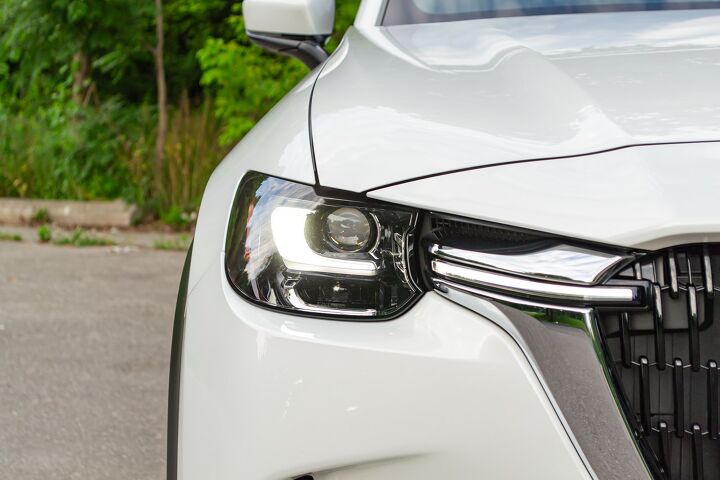
In America, the CX-90 PHEV starts from $48,820 including destination, nearly $8,000 more than the entry point for the turbo model. That's comparing two different trims however; when looking at a like-for-like situation, the gap drops to an even four grand. Going for the high-power Turbo S model? That one's actually pricier than the PHEV, when comparing similar trims.
That puts the PHEV in an awkward space. As a buyer, you'd need to be very committed to short all-electric trips to see an appreciable benefit. Emissions are slightly lower for the PHEV as well, while the towing capacity penalty is sizeable. This Canadian-spec tester's US-equivalent sticker is $58,920.
In Canada, where the trim names are all different, this tester is known as the CX-90 PHEV GT, the highest trim for the plug-in. It's a $9,000 CAD surcharge over the equivalent 280-horsepower gas model. However, depending on where you live, a good chunk of that difference can be made up with PHEV tax incentives. The as-tested price of our model is $66,945 CAD.
Verdict: 2024 Mazda CX-90 PHEV Review

Mazda's first plug-in hybrid is a composed one. The 2024 CX-90 PHEV does a good job combining the best of both worlds: ICE and EV, as well as mainstream and premium. This is leaps and bounds ahead of the MX-30.
As the pricing shows, it's likely going to be a hard sell for folks. As well-integrated as the powertrain is, it isn't as effortlessly smooth as the turbo-six. Those who have schedules full of short trips, or folks who can take advantage of serious tax incentives, will see the appeal of the plug-in, and it would end up saving them in the long run. For everyone else, the standard engine is a winner, and it's a win for Mazda to offer buyers more choices to better suit their needs.
Become an AutoGuide insider. Get the latest from the automotive world first by subscribing to our newsletter here.
2024 Mazda CX-90 PHEV | |
|---|---|
Engine: | 2.5L I4 + PHEV |
Output: | 323 hp, 369 lb-ft |
Transmission: | 8AT, AWD |
US Fuel Economy (MPG / MPGe): | 25 / 56 |
CAN Fuel Economy (L/100km / Le/100km): | 9.4 / 4.2 |
Starting Price (USD): | $48,820 (inc. dest.) |
As-Tested Price (USD): | $58,920 (inc. dest.) |
Starting Price (CAD): | $57,095 (inc. dest.) |
As-Tested Price (CAD): | $66,945 (inc. dest.) |

Kyle began his automotive obsession before he even started school, courtesy of a remote control Porsche and various LEGO sets. He later studied advertising and graphic design at Humber College, which led him to writing about cars (both real and digital). He is now a proud member of the Automobile Journalists Association of Canada (AJAC), where he was the Journalist of the Year runner-up for 2021.
More by Kyle Patrick






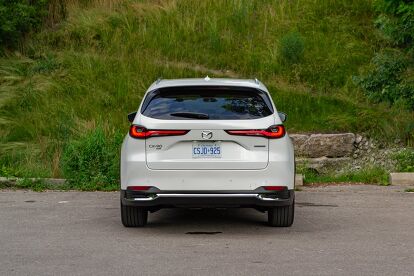




















































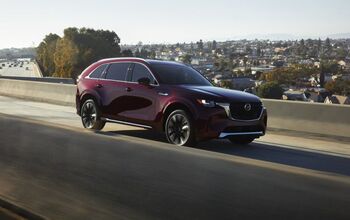


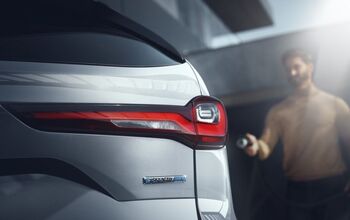









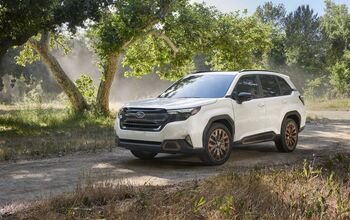


Comments
Join the conversation